MiG MFI - experimental fighter
In the design, carbon plastics and polymer composites are widely used, whose share in the total mass is about 30%.
Reasonable sufficiency has come to replace the comprehensive use of composites several years ago that seemed to be the most promising structural materials. In practice, it is difficult to include such parts in the power structure, organization of the joints and transmission of forces is difficult, and their extremely low maintainability during damage prevents them from operating. The broken fibers are practically not amenable to recovery under normal conditions, forcing to completely replace the aggregates and limiting their use to small-sized, integral parts. The design of the MFI made of composites made panels of the wing, PGO, covers and sash hatches.
Aluminum-lithium alloys make up 35%, steel and titanium - 30%, another 5% falls on other materials (rubber, glass, etc.).
Cruising supersonic must provide two AL-41F TRDDFs. Engines equipped with swiveling nozzles have a maximum afterburner thrust of 14000 kgf with a dry weight of 1585-1600 kg. With a normal take-off mass, they provide the aircraft with a thrust-weight ratio of about 1,3. The assigned resource of AL-41F before the first repair is equal to 1000 hours, the resource of moving parts of nozzles is 250 hours. The engines passed the full range of flight tests at the MiG-25 flying laboratory (306 board). The maximum speed of the MFI should have been M = 2,6, and the long cruising, achieved without the boost, is M = 1,4-1,6. The afterburner is considered as a short-term combat when you catch up with the enemy or provide a tactical advantage.
The aircraft is equipped with a ventral air intake, divided into two sections (each servicing its own engine). The air intakes have an upper adjustable horizontal wedge and a lower lip that is deflected, providing smooth control of the flow at the inlet. The design of the input device has side bevels and a vertical central wedge. The 1.44 equipment was provided with an in-flight refueling system.
The lower location of the air intake is also advantageous for the requirements of high maneuvering characteristics, allowing you to avoid disrupting the flow during intensive maneuvers with access to large angles of attack and turns. The aerodynamic “duck” scheme with high bearing properties is subordinated to the same. In addition, PGO performs the functions of damping when reaching the critical angles.
The wing mechanization - two-section reject socks, ailerons and two pairs of flaperons, occupying almost the entire front and rear edges, are connected to an electro-remote digital control system that controls the behavior of a statically unstable machine. Its characteristics make it possible to achieve a true symbiosis of the airframe, thrust vectoring engines and on-board equipment, at the same time simplifying the work of the pilot, increasing the sensitivity of control and protecting the machine from going to extreme and extreme modes. In total, the aircraft carries seven pairs of control surfaces, including unconventional ones, such as the rudders on the lower keels and "flippers" in the root parts of the wing.
The decrease in radar visibility, achieved, in general, by the layout of the aircraft and the radio absorbing coating of its surfaces, can be assessed by 1.44 only by specific design solutions, which reduce the EPR and screen some aggregates that are particularly noticeable in this spectrum. Coverage is not necessary for the initial flight tests, the aircraft does not carry. In addition to the overall layout with smooth contours, including an oval, flattened cross-section of the fuselage, stealth contributes to the internal placement of weapons and the shelter of engine compressors, which also give noticeable "bursts" during irradiation. The air channels leading to them are S-shaped. The gaps at the joints of ailerons, flaps, wing socks and rudders are minimal. The same subtle technology is subordinate to the installation of spaced keels on the wing with 15 ° outward.
At the same time, a number of solutions, albeit related to the individual features of 1.44, do not fit into modern ideas about ways to reduce EPR: lower keels, which play the role of corner reflectors, disregard of tested sawtooth edges of hatches and panels, angular keel, wing and fuselage joints, gargrot with the same "corners".
The movable part of the lamp when opening rises on two levers with simultaneous shifting back. Such kinematics can significantly reduce the effort required when opening (with a 10 mm glazing thickness, the lid weighs more than 150 kg) and makes it easier to drive.
Tricycle landing gear with nose wheel. Nose rack with two wheels 620x180 retracts downstream. Due to the tight layout in the area of the air intake, it does not fully fit into the niche and the two doors that close it have a convex trough-shaped shape. The main racks with depreciation of various types are retracted forward. They carry low pressure 1030x320 wheels with ventilated brakes. The use of wheels of the same type as on the Su-25 and Su-27, due to the desire to simplify the design of the experimental machine.
1.44 does not carry armaments, however, bays are reserved and units for its installation are laid. It was assumed that the fighter will carry the built-in 30-mm gun with an increased effective fire distance, and its embrasure will be closed by a movable flap to reduce radar visibility and for high-speed flight requirements. In the internal compartment 1.44 was supposed to place on ejection installations most types of existing air-to-air and air-to-ground missiles, and also 5-generation air combat missiles specially designed for MFIs.
Heavy missiles, bombs and outboard tanks could be suspended on three pairs of underwing holders, the nodes of which were also laid in the wing structure. However, the variants of external load were not the main ones, increasing the visibility and not allowing to perform supersonic flight.
1.44 did not carry the full range of aim-navigation equipment, limited only by the necessary piloting systems (this explains the small cone of the abnormal radar, and some radiotransparent fairings, such as keel caps, were simply made up on the first machine). At the same time, all units of the complex were tested, including at flying laboratories. The aircraft was supposed to install a 5-generation Doppler radar with a phased antenna array, which allows tracking more than 20 targets and simultaneously attacking 6, as well as sighting equipment of optical and IR channels for detecting, tracking and targeting in low visibility. The use of such equipment is considered as a priority under the terms of secrecy (radar gives the aircraft a powerful radiation).
To accommodate the rearview radar and onboard jamming station, compartments in keel beams were provided.
Much attention was paid to the automation of problem solving, especially significant in the internal deployment of weapons, when missiles hidden in the GOS compartment need external target designation from the aircraft systems up to the very moment of launch. In the interaction of the pilot and the machine, the principles of “see-beat” and “let-forget” were implemented to the maximum.
Preliminary work on the creation of the fifth generation heavy fighter for the Air Force and Air Defense, designed primarily to replace the Su-27 and, partly, MiG-31, began at the end of the 1979 year, when priorities for the future fighter were outlined . They should have been the following areas:
multifunctionality, assuming equal opportunities in actions on air and ground targets;
low visibility in all spectra (visual, radar, thermal and electromagnetic);
super-maneuverability, which involved the implementation of unconventional techniques and tactical elements of air combat, as well as expanding the range of possible flight regimes without reaching the brink of stalling and stalling;
supersonic cruising flight speeds, allowing for an energetic air combat manner, imposing initiative on the enemy and a quick response to changing tactical conditions.
Preliminary common features of the fighter, which received the temporary cipher KB "product 5.12", took shape at the beginning of 80's. The name, to preserve secrecy, was given by analogy with what was used in the working documentation on the MiG-29, with further refinement of the modification (9.12, 9.13, 9.15 and others). Thus, even with an accidental information leakage, the impression was created that this was one of the twenty-ninth variants. The general management of the topic was carried out by General Designer Rostislav Belyakov, Georgiy Sedov was appointed the chief designer (Yuri Vorotnikov replaced him at 1997).
In the meantime, there were reports of nearly unfolding American works on the project of the advanced tactical ATF fighter (Advanced Tactical Fighter). Without delay, the decision at the state level took place here as well - a closed joint decree of the Politburo of the Central Committee of the CPSU and the USSR Council of Ministers, adopted in 1986, stipulated the main stages, terms and responsibilities of the IFI program - a multi-purpose fighter. Leading aviation research institutes, Defense Ministry and Air Force with the participation of the Design Bureau formed the conceptual image of the new fighter, on the basis of which the Air Force formulated a clear technical task for a promising aircraft.
When designing it, it was based on the same “three C” formula, but its priorities changed somewhat:
supersonic cruising speed;
maneuverability;
stealth
The implementation of quite contradictory requirements required a large amount of research. The shift in emphasis led to significant differences in the MFIs scheme from the fighters of the previous generation that had just entered service: they had to abandon the integral layout, which significantly increased the midsection and the cruising supersonic that was contrary to the requirements, the wing lost its influx and acquired a positive transverse “V”, new control surfaces were proposed which still had to find a name. At the same time, in the IFIs, according to one of the designers, the “evolved MiG-25”, a high-speed fighter “grown up” to a qualitatively new level, was viewed. The aerodynamic concept of MFIs was worked out at TsAGI, which recommended the following solutions for their implementation:
“duck” scheme, advantageous both in terms of maneuverability and best bearing properties, with rear centering, unstable statically;
large wing area and a triangular shape with a sweep along the leading edge 40-45 °;
engine thrust vector deviation to improve take-off performance and super maneuverability;
ventral adjustable air intake, optimal on supersonic and subsonic, as well as at low speeds and high angles of attack and having less radar visibility due to "shading" from above the fuselage;
internal or conformal placement of weapons.
The advanced design of the advanced fighter was carried out by specialists from the OKB Design Bureau. A.I. Mikoyan in 1985. Its peculiarity consisted in the fact that it was carried out in two parts - by a multifunctional front-line fighter and an air defense fighter, called the MFI, and by a light front-line fighter - LFI. It was assumed a high degree of unification between the two aircraft. In 1986 A.I. Mikoyan, together with other participants in the work, successfully defended the advance design of the MFI and LFI aircraft, winning the competition from the Sukhoi Design Bureau. In the same year, a joint party and government decree was issued, in accordance with which the MMP for them. A.I. Mikoyan was entrusted with the development of IFIs in the “weight category” of the Su-27.
After passing through the mockup commission that approved the look of the IFI, the refinement and refinement of its scheme continued. The first working drawings for the “5.12 product” were already released in the 1986 year, but the original edition (by this term, adopted in the KB practice, is another option in the process of creating a machine) has undergone significant changes. In addition to attracting a mathematical apparatus and a huge amount of blowdowns in the TsAGI wind tunnels, research on the “5.12 product” on large-scale controlled flying models was launched.
Four-meter half-toned “fives” discharged from a helicopter suspension went into extreme modes, demonstrating the behavior and controllability of a future car at supercritical angles of attack and helping to master methods for getting out of dangerous conditions.
Due to the secrecy of the topic, the tests were conducted in the steppes of the NIK Air Force test site near Aktobe. The flights were confined exclusively to the “windows” between the spans of the western reconnaissance satellites, and the models themselves had a yellow-green hiding against the terrain. It was prescribed to pick them up in minutes after landing.
These tests were not going smoothly; breakdowns and analysis of incidents after “controlled falls” were common, but they were paid for by the information from telemetry films and onboard recorders, which immediately went to work. The records made it possible to judge the effectiveness of certain solutions, they were studied by test pilots who received a unique opportunity to evaluate the behavior of the future aircraft, especially in hazardous conditions. In flight models with conventional mechanical control by the 1990 year, it was possible to achieve stable behavior without a tendency to stall at angles up to 60 ° and spin characteristics, enviable, and for machines of a “stable” scheme. In itself, this was promising, as it was previously believed that a statically unstable aircraft of a similar layout, not equipped with a control system with an artificial stability preservation, was practically uncontrollable.
Based on continued research and searches, changes were made to the design. Innovations, sometimes substantial, were also introduced at the first prototype assembled at the plant at the design bureau. Work on it began in 1989, already under the code "project 1.42". By 1994, the project underwent six revisions, four of which were tested on flying models.
Originally it was planned to equip the aircraft with engines with flat nozzles, reducing radar visibility and shielding disks of turbines. However, this design, at first glance, more simple, proved to be difficult to implement because of the poor distribution of temperature fields in the "box" of the nozzle during the transition from circular to rectangular, which threatened to burn through the walls. The transition to the flat nozzles had to be postponed, but in the meantime the engines managed to control the thrust vector by deflecting the usual round adjustable nozzles, and from 1991, they were introduced into the main editorial board.
The wing of the MFI with a straight leading edge without the influx differed from that which was generally accepted on previous generation fighters. The formation of vortices flowing down the leading edges and having a positive effect on stability (Academician TsAGI Byushgens figuratively compared them to the “rails on which the plane slides without stalling at high angles”) are designed to carry out PGO beams, the location of which we had to painstakingly select from installation, thickness and elevation above the wing depends on the optimal drift flow and the descent of vortices, forming a flow around the wing. This is especially significant with the adaptive design of the wing, when the joint work of deviating socks and flaperons changes the pattern of flow, “adapting” the wing to the flight mode.
The task turned out to be difficult: the first two editions with the “clean” PGO were replaced by the next one, in which the PGO blades (the term “stabilizer” lost its meaning, since the front plumage of the MFI performs mainly other functions) received an impressive whirling tooth. In practice, this solution has already been used in the development of the MiG-23 - then a rotary cantilever was equipped with a tooth, and then a center-plane influx, which had a positive effect on maneuverability.
The corresponding transformation has undergone and placement of weapons. A variant of the internal cargo compartment in the upper part of the fuselage was being worked out, from where rockets would be thrown out by hydropneumatic pushers after the flaps were opened (a design worked out on the MiG-31, albeit with underfusual half-wall placement). Such a placement promised some advantages, facilitating the capture and launching of targets for over-and-over maneuvers. However, it would inevitably cause problems in operation - to lift rockets to four meters high, the mass of which even the lightest Р-73М exceeds 100 kg, and long-range missiles reached 300-400 kg, special cranes and platforms for each aircraft would be required - too expensive, cumbersome and completely unacceptable solution for domestic practice. As a result, the armament compartment occupied a position in the lower part of the fuselage, where the missiles could be suspended directly from the carts with the help of well-known simple means.
MFI was supposed to get a new generation radar with a phased antenna array. This design, consisting of many small modules, each of which is an independent mini emitter, has much greater speed and efficiency than a conventional radar with a rotating antenna mirror, less mechanically complex and more resistant to damage. The radar of the "tail protection" with the detection of the enemy in the rear hemisphere and target designation of missiles, including with a reverse launch, launched backwards in flight (this technique was worked out for the P-60 and P-73 missiles) was a novelty in the weapons complex.
In the meantime, when building a prototype machine, problems arose that turned out to be more significant than the inevitable difficulties of designers and technologists in the new business. By the end of 1991, the entire Soviet military industrial complex went into a violent crisis. The “Defense” has lost its former privileged status, the funds allocated have been catastrophically reduced, and many knowledgeable specialists have left the enterprises and design bureaus.
To this were added defaults and a breakdown in economic relations, an attempt to overcome which was the merger of the Mikoyan Experimental Plant at the Design Bureau (ANPK MiG) and MAPO, and with 1996, the other related enterprises, as well as Aviabank. The heterogeneous structures entangled “in one cart”, however, did not solve the problems. The financial and production orientation of the new leadership did not have the best effect on the life of the design bureau, which was not adapted to immediate returns. “Defense” in Soviet times could not serve as an example of economical spending of funds, but now new opportunities sometimes led to the disappearance of money without any return.
With regards to the MFIs, this had depressing consequences: the finances allocated for specific items “dissolved” in the bowels of the military industrial complex and neighboring structures, while the construction of the car stopped at times. Occurring around the fighter "disassembly" sometimes reached the presidential apparatus, but the work proceeded neither shaky nor roll. It happened, for example, when installing a control system for which the Nizhny Novgorod plant "Gidromash" did not agree to install steering cars without prepayment. Other systems that had to be conserved were also incomplete. Not getting along with the new leadership, test-pilot Mikhail Kvochur left the company, who was to lead the IFI.
In the end, the aircraft, although not yet equipped with part of the units, was transferred to LII at the beginning of 1994. In December, it was the first high-speed taxiing with the separation of the front rack. After this, the “stagnation era” reappeared. The plane was gathering dust in the hangar, and its display, expected from year to year, was constantly postponed under plausible excuses. The vacuum was filled with stupid information from representatives of the company and MAP, confirming the existence of a new fighter (which was unusual even with the arrival of publicity - not a word was said about the presence of Sukhovsky C-37 until its first flight).
At the air show in Le Bourget in June 1995, Deputy General Designer Anatoly Belosvet said that the company expects to show 1.42 at an exhibition in Zhukovsky. However, the demonstration was then canceled just a few hours before the opening of MAKS-95, explaining that by a ban on the military, although the newly painted plane was ready for roll-out. Only the leadership of the Ministry of Defense and members of the government allowed into the secret zone of the hangar.
The press service, compensating for the failed event, distributed the text of an interview with Rostislav Belyakov, which said that 1.42 was created in response to the American ATF program, and the design bureau “firmly adhered to meeting the characteristics of the project with the requirements of the Air Force”. As a result, the MFI was supposed to become not only equal to the American fighter, but also to "surpass it in a number of characteristics." The last statement regarding the already flying American plane then became almost ritual, repeating from year to year.
Meanwhile, the IFI was once again officially mentioned March 21 1996 of the year when the training MiG-AT was shown. The Director General of MAPO-MiG, Vladimir Kuzmin, announced that, subject to adequate funding, the new fighter could be lifted into the air "within six months." The 1.42 demonstration was also expected at MAKS-97, it was postponed from day to day, but in the end it did not take place again.
As a result, the MFI program has become increasingly behind the US ATF. Pull off and further became impossible. The success of the competing neighbors also played a role: 25 of September 1997 sukhovtsy raised their prototype front-line fighter S.37 "Berkut" into the air. Finally, after long delays, it was decided to demonstrate the IFIs, albeit flightless, in conjunction with the show on the company's 60 anniversary celebration.
The aircraft was shown on 12 on January 1999 of the year at LII, where a lot of journalists were invited, military attaches of foreign countries and a large contingent of domestic dignitaries, including members of the government, on whom the fate of 1.42 depended. Among those who arrived in Zhukovsky were Russian Defense Minister Igor Sergeyev, Air Force Commander Anatoly Kornukov, Economy Minister Andrei Shapovalyants and presidential aide Yevgeny Shaposhnikov.
Following the show, a press conference was held. Questions were answered not only by Mikhail Korzhuyev, Director General of AIPK MiG, and Chief Designer Yuri Vorotnikov, but also by representatives of the government. If the Mikoyan people expressed confidence in the success and reality of the declared characteristics, then the ministers of defense and economy behaved more restrained, evasively speaking about the financing of the tests.
In the presence of distinguished guests, the Mikoyan citizens found themselves in a difficult situation: all the advantages and characteristics of a fighter that had not yet “pierced the air” sounded as if they had been confirmed in practice, and the presentation of the first prototype itself had not stocked machine. Subsequent newspaper publications, which were completely illiterate and often bore the character of outright harassment, added fuel to the fire.
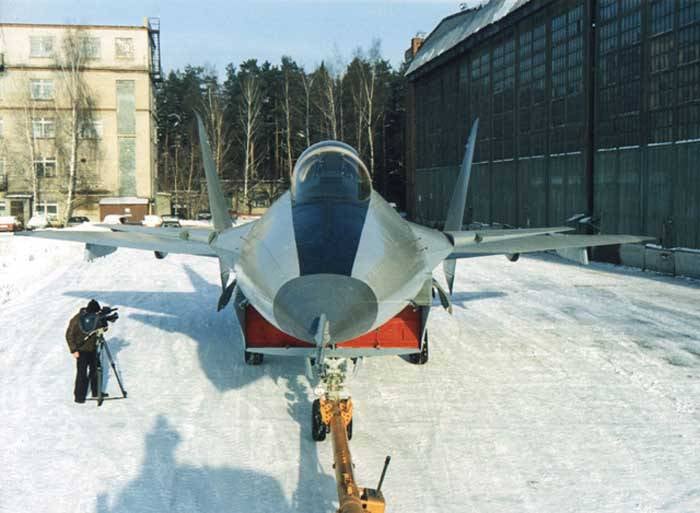
At the same time, the very first publication with a detailed description and photo of the “MiG 1.42” appeared a day before the official display in the American aviation weekly Aviation Week & Space Technology from 11 in January 1999.
29 February 2000 g. Plane for the first time off the ground. The test flight took place at the flight test and development base (LI and DB), located at the airfield of the Flight Research Institute. M. Gromov in the suburban town of Zhukovsky. The flight, which lasted 18 minutes (from 11: 25 to 11: 43 Moscow time), was carried out in full accordance with the task. The plane gained an altitude of about 1000 m, made two circles above the airfield at a speed of 500-600 km / h, after which it successfully completed the landing.
27 April 2000 d. 1.44 made a second 22-minute test flight. In flight, a number of aircraft and propulsion systems were tested, and, besides, unlike the first flight on a fighter, the landing gear was released and retracted.
As for the aircraft itself, the sample shown was somewhat different from the 1.42 project in its complete design. Therefore, the first flight model of the MFI was built in the performance of the “1.44 product” with a well-defined and rather narrow target — evaluating the aircraft in the air, determining the characteristics of its behavior and controllability, and also “running in” new engines.
At the moment, work on the project is stopped.
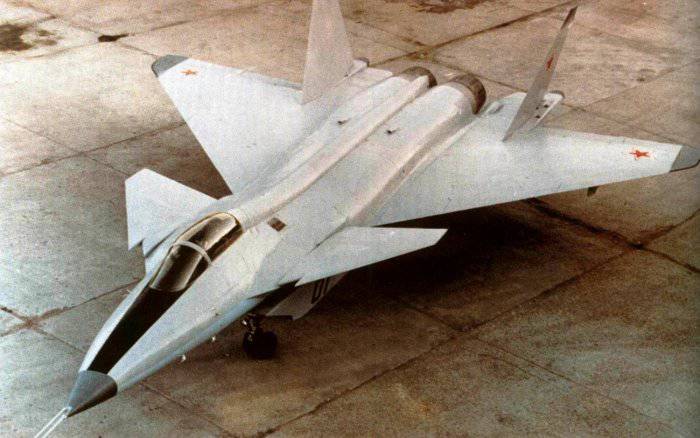
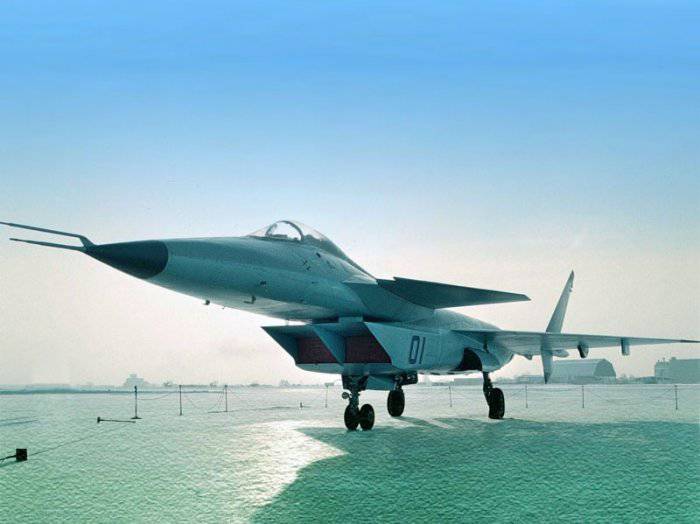
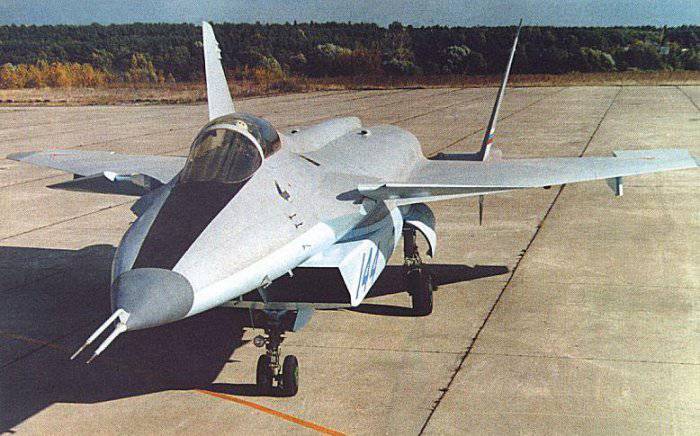
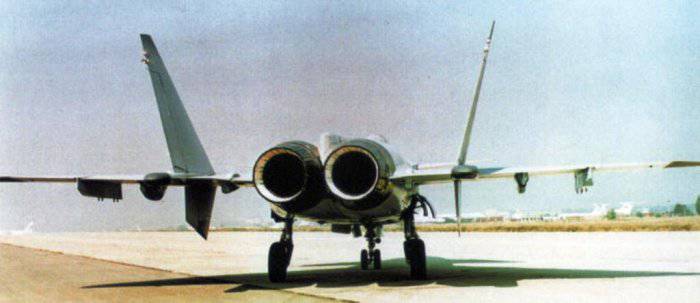
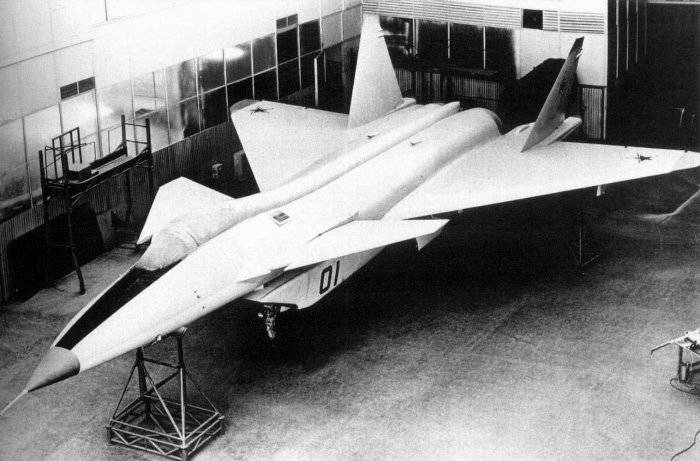
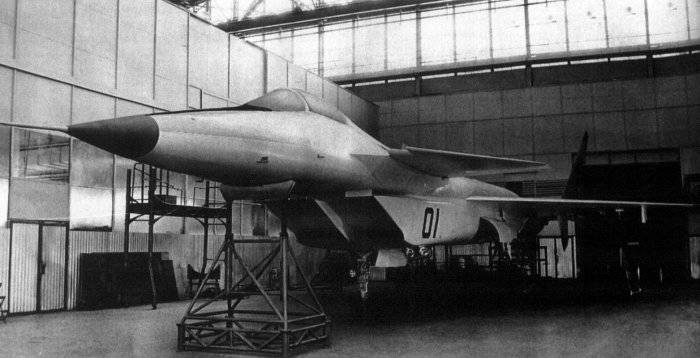
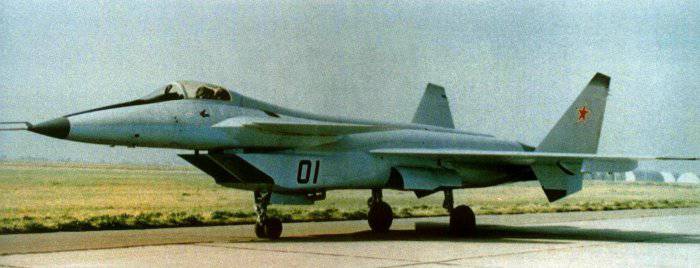
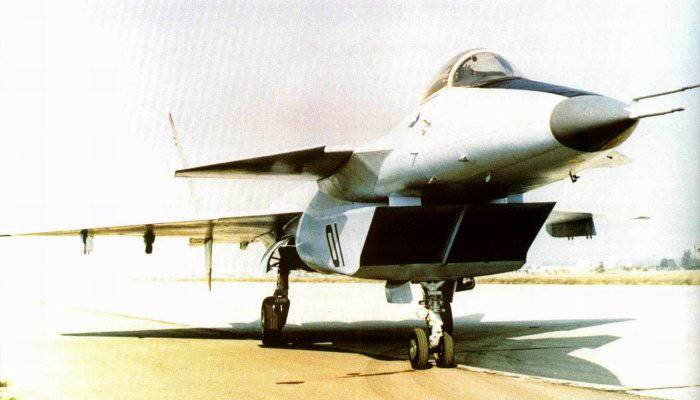
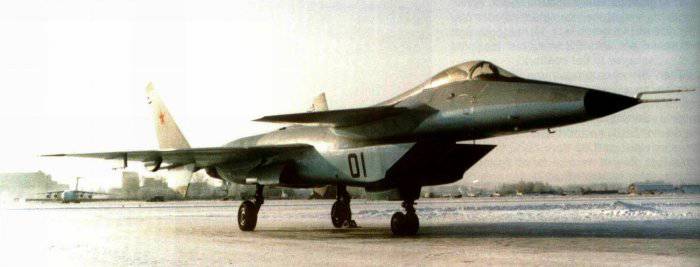
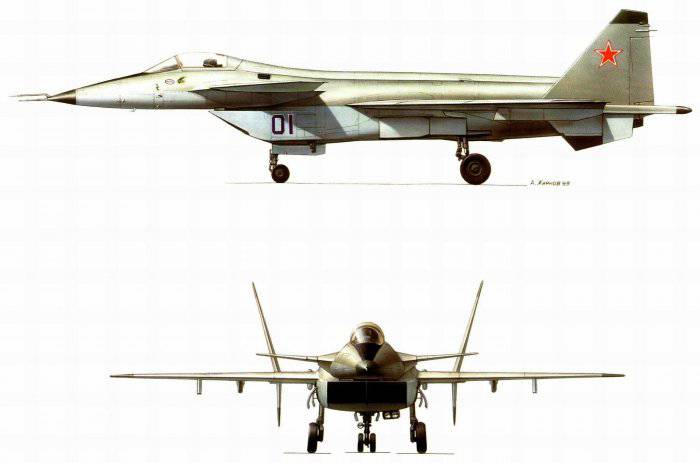

Information